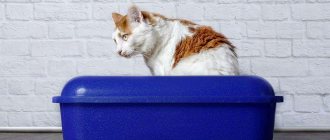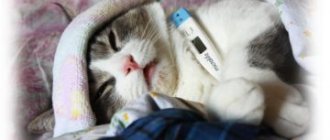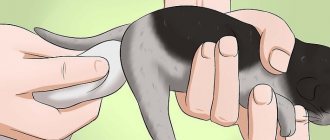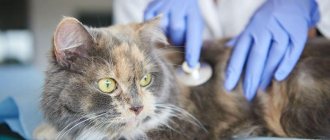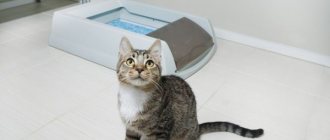9394Administration
A furry friend has appeared at home and you can admire him around the clock without taking your eyes off him. But, do not forget that he is a living creature and wants to eat, and then goes to the toilet. That is, you need to deal with them so that it does not darken the owner’s joy.
But what to do if the kitten does not go to the litter box, while demonstrating its protest to the indicated place every day? The pet does not walk and any owner will get tired of this, because he will need to be cleaned up regularly.
Mother teaches kitten
The first thing you should know: you cannot take a very small kitten from a cat, that is, younger than 1.5 months. Many large nurseries that care about the health and behavior of animals give away kittens after three months.
The fact is that in addition to feeding milk, a mother cat sets an example for her cubs on how to eat, how to hunt and protect themselves. But the most important thing for the owner is that the adult cat shows the cubs where to go to the toilet. This is why it can be difficult to immediately train a one-month-old kitten to the right place.
Strong pain
Usually, mustaches stoically endure any pain; they hide their ailments from their owners until the last moment. But sometimes the card goes extremely wrong. There are different diseases, including urinary tract infections, kidney diseases, bladder diseases, etc. With many ailments, urination is accompanied by pain, which the animal involuntarily associates with its litter box (i.e., it forms negative associations). The cat tries to get rid of the pain, as it seems to her, in a radical way - she begins to urinate in another place.
Bringing the kitten home
When the cub is separated from its mother and begins to live independently, it is taken to a new home.
Before you bring a kitten, you should first prepare everything:
- Buy a tray.
- Select and purchase filler.
- Buy a scoop for cleaning the tray.
- Choose a place for the toilet.
As soon as you bring the kitten into the house, place it in the litter box. To create the smell, you can take a napkin from the house where the kitten used to live, which was lying in the mother’s tray.
Show the kitten his toilet and let him get comfortable. The litter box must be in a secluded place so that the kitten feels comfortable and can do what he needs in silence and without distractions.
The next stage is to let the kitten get comfortable in the space. At the same time, he should not be frightened: nervous animals often have problems with training and adaptation. If the kitten gets scared, it may stop going to the litter box and it will be difficult to force it. The question of why a kitten doesn’t go to the toilet arises quite often, especially in the first months of its life in a new apartment.
In order for him to stop going to a place not intended for these purposes, you will have to make a little effort. In many ways, everything depends on the character of the pet and its intelligence, but occasionally there are cats that mark their territory. Usually this problem arises with the onset of puberty and there are other methods of solving it.
Perhaps the animal will learn on its own, but the owner will still have to help him and let him understand how to do it correctly.
What to do if the kitten does not go to the toilet in a big way?
Are you unable to take your pet to the doctor? No problem. An enema with lukewarm water and a small amount of Vaseline oil will help him recover successfully. Depending on how many days or weeks your mustachioed patient is, its volume can reach 1-5 milliliters.
As a syringe, you can use a five-cc syringe without a needle. Fill it with the required amount of liquid, lubricate the cone with Vaseline and gently but firmly, with some pressure, insert it into the kitten’s anus. After some time, your patient will poop easily and painlessly.
Interesting video: A veterinarian gives an enema to a one-month-old kitten
Toilet training process
The little kitten goes to the toilet quite often and can't stand it. The owner will have to learn to determine when he wants to do his business. As soon as the baby begins to squat, he should be calmly transferred to the tray. If suddenly the kitten manages to make a puddle, it should be wiped with a strong odor-repellent agent.
A cat litter box without litter and with one mesh is, of course, convenient for the owner, it is easier to clean and no money is spent on it, however, it can be difficult to immediately accustom a kitten to the litter box for the reason that the cub does not understand what they want from him.
Under natural conditions, animals relieve themselves on the ground or in the sand, and then bury them. You can imitate natural conditions if you use bulk filler. The kitten will be happy to dig into it and this will help make it stop going to the toilet in other places.
Additionally, when the process of accustoming to a place occurs, you can use a special spray. Please note that there are two types of training aids:
- Repellent. They have a strong aroma and mask the smell in the place where the kitten went.
- Attractive. This spray is sprayed directly into the cat's litter box so that habituation in the apartment takes place as quickly as possible.
Usually, training a kitten to use a litter tray is not difficult. Cats are clean animals and get used to going to one place, but for the pet to get used to it quickly, this place must be comfortable.
How to choose the right litter box for your cat
Cat litter boxes are:
- The simplest plastic container
This is a trough, most often rectangular with rounded corners. The troughs are economical, accessible to all segments of the population and are favorably accepted by cats. These trays are pleasing to the eye with a variety of colors and are easy to wash and use. Disadvantage: cannot be used without filler.
- Trough-tray with mesh
The same container, only supplemented with a plastic drainage mesh grid, which can be attached either to the sides or inserted inside on legs. The filler is required depending on the wishes, urine easily seeps down, and solid waste remains on the mesh and is easily disposed of.
The disadvantages of a tray with a mesh are that it must be washed after each use; when trying to bury traces of its own vital activity, the cat can catch its claws on the mesh and tip the contents of the tray onto the floor.
- Tray with high sides
It justifies itself completely, especially if the pet is large and strong. A tray with removable sides that secure insert bags, which are easy to remove and throw away along with the contents. The additional package includes the same drainage grid as for the trough.
There is only one minus - such a vessel is not suitable for a kitten: the sides are too high.
- Tray house
A godsend for shy cats! The house, which looks like a closed carrier, is a real cat bio-toilet, where the cat can quietly retire to perform the desired action. In addition, it eliminates the risk of “inaccurate hits” and prevents the spread of aromas. Disadvantages - to wash, you need to take it apart - one, cumbersome for a cozy corner of “introspection” - two, cats often mistake it for a real house for relaxation - three.
- Automatic toilet
This is truly a miracle of engineering genius, providing a carefree life for cat owners. Self-cleaning, wet cleaning, disinfection, no odors, practically no maintenance - a lot of advantages!
The downsides are: special means for maintaining cleanliness, connection to water supply and electricity, noise made when washing, high price. And the biggest drawback is that cats are almost universally afraid of noisy toilets and do not want to shit there. And how to teach a kitten to go to the litter box, pray tell, if he is simply afraid of it?!
No, you need to start toilet training with an ordinary tray - it’s inexpensive, and in the category: “Which tray is better?” it has clear advantages.
Training errors
If your kitten does not go to the toilet, this may happen for the following reasons:
- The tray is not convenient enough.
- The animal was scared in the place where the tray was installed.
- The kitten was taken too early, and the mother cat did not have time to teach her to go to the litter box on her own.
- The animal has health problems, so it does not have time to reach the place.
If a kitten does not go to the toilet, this problem must be corrected as quickly as possible: the main character traits are formed in childhood, and it will be more difficult to retrain later. The owner must be persistent, but at the same time gentle, so as not to scare the small pet.
Hygiene needs to be paid attention from the very first days of the animal’s appearance in the apartment. The spray is an excellent tool if you need to wean off marks and change your pet's behavior when the kitten does not go to the toilet.
Learned behavior
But “marks” can also play a cruel joke on the owners - after all, they remain where the cat has already done its business. That is, on the carpet or in the same slippers or shoes. And the shoes may well become a kind of “double” of the tray, and for obvious reasons. That is why it is so important to quickly eliminate the consequences of an accident. And not only in terms of cleanliness and hygiene, but in terms of eliminating the “beacon” smell. At one time, in response to a reader’s letter, we prepared a separate publication. Please take the time and read it, there is a lot of useful practical advice there.
Reasons why kittens may have difficulty walking
The cat's babies are not only blind, but also deaf. Newborn kittens do not have a fully formed nervous system, so they rely on their sense of smell and touch to navigate in space.
The first thing kittens pay attention to is the smell of their mother, which they are able to detect from a distance of 60 cm. In the initial stages, kittens sleep and eat more. Already from 10 days old, babies begin to gradually open their eyes. A transition period begins, lasting until the kittens begin to walk - approximately 15-20 days of life.
Kids learn to see and listen to the world around them, and at the same time, the musculoskeletal system is strengthened. Kittens are starting to learn to walk. Attachment to each other and to the mother herself appears with the beginning of the socialization stage that follows the transition period.
It's not just the mother cat who has to look after her offspring. The care of the owner plays a big role. The owner of a cat and kittens must monitor all stages of development, promptly noting possible violations. One of these disorders may be the lack of normal learning to walk.
A serious reason to seek help from a veterinarian is the complete inability of the kitten to stand on its paws, a loud squeak at this moment, or a complete refusal to walk.
All this may indicate the development of dangerous pathologies. The cause of weakness in the limbs, pain and other manifestations of discomfort can be both congenital and acquired disorders.
Congenital causes that prevent kittens from learning to walk normally are:
- serious kidney disease;
- hip dysplasia (mismatch of the head of the femur with the pelvic cup);
- rickets;
- tumor processes;
- dystrophic changes in the spine.
The inability to walk can also occur in a physically developed kitten. In such cases we are talking about acquired diseases. The cause may be injuries of varying severity.
Veterinarians note genetic heredity. Thus, hip dysplasia is more common in kittens of breeds such as Maine Coon and Scottish Fold. Congenital anomalies are less commonly diagnosed in Norwegian, Persian and Siamese cats. When purchasing a purebred kitten, the future owner should carefully check the documents with the pedigree, which should indicate the presence of pathology in the family.
If the kitten is 1.5 months old, it should already be active, run, jump a lot, and climb vertical surfaces. If this does not happen, you should seek help from specialists.
Signs of constipation in kittens
Constipation can rightfully be called one of the most common difficulties that a growing animal has to face. You can determine if there are difficulties with bowel movements and help your kitten by noticing the following signs:
- frequent attempts to defecate;
- dry and hard excrement;
- noticeable discomfort of the animal during the next attempt to empty the intestines (plaintive meowing, fear);
- the presence of bloody or mucous discharge in the stool;
- complete lack of appetite;
- weight loss.
Treating constipation in kittens with massage
A kitten cannot go to the toilet often due to various diseases of the gastrointestinal tract. In this case, treatment procedures and medications depend on medical prescriptions.
A kitten that is unable to empty its bowels on its own urgently needs the assistance of its owners. This is especially true for small kittens, the young cat refused to properly care for them due to inexperience and immaturity. The procedure is not difficult, the main thing is to follow all the tips below for babies aged from one day to three months:
- Before starting stimulation, it is extremely important to position your pet comfortably. The most suitable position is considered to be when the kitten lies on the left hand, with its butt turned towards the owner. You should not put too much pressure on the fragile body of your furry baby, but you should squeeze it in such a way as to eliminate the possibility of falling out.
- Prepare a pre-moistened napkin or clean cloth. By placing it on the right side before starting the procedure, the cloth will be useful for stimulating the anus. This needs to be done by the kitten in order to replace a completely natural process usually carried out by the mother.
- You should start the massage by moving your right hand with a napkin towards the kitten’s anus. Stimulating the animal's anus with such a simple massage will help relax the animal's muscles, since it will be an imitation of licking by a cat.
- The massage can occur every day and last about a minute. If results from rectal stimulation are not achieved, you should visit a veterinarian. The animal must definitely go to the toilet for any need.
- After changing the position of the rag on your hand and turning it with the clean side, it is important to continue massaging the kitten's anus. A towel that gets dirty needs to be turned over from time to time. Once cotton swabs, which many people prefer to fabric scraps, become dirty, they should be thrown away immediately. By the way, it is advisable to take into account that kittens of the newborn period have soft stools. The transition from liquid food to more solid food occurs after the second month of a pet’s life.


